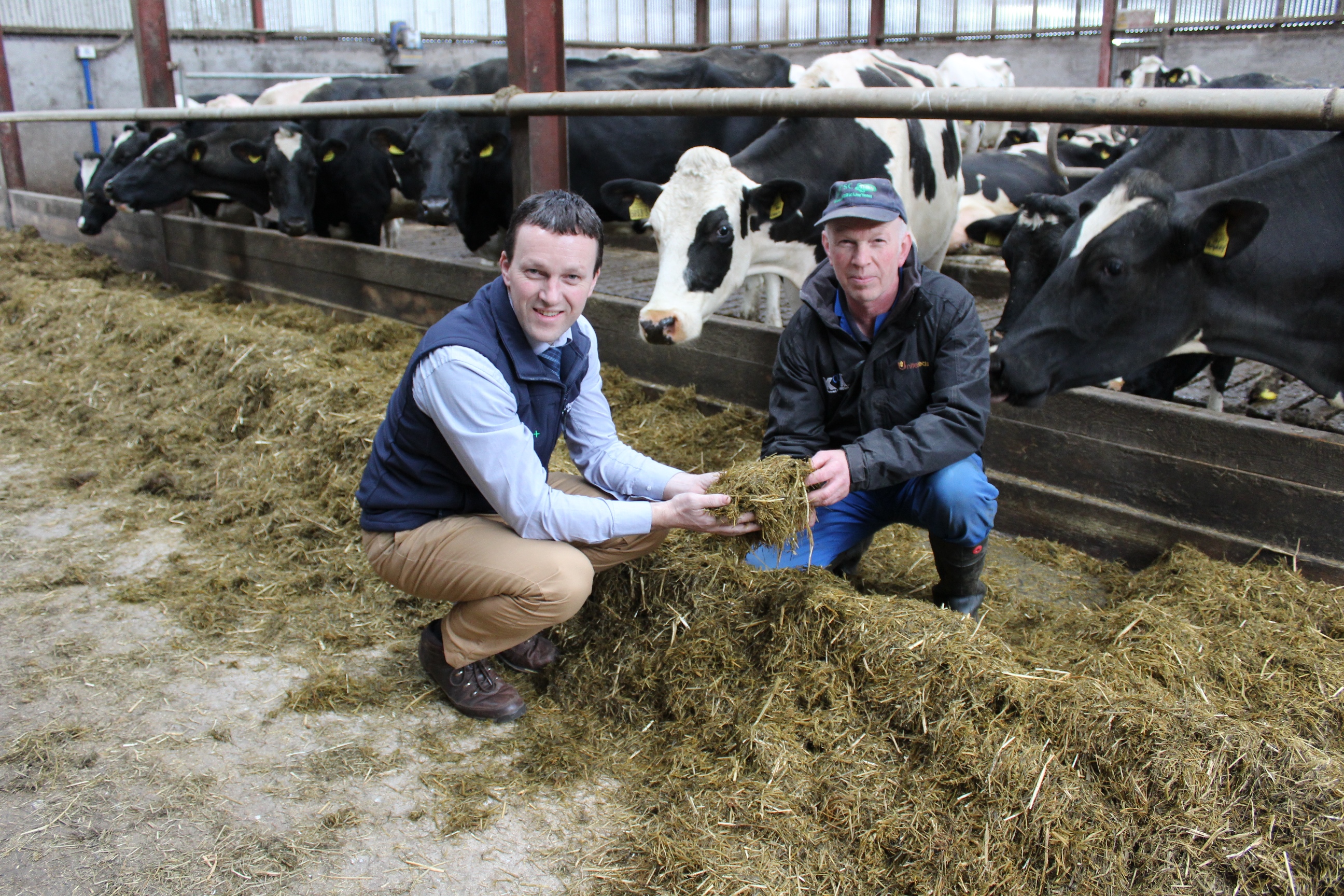Given his herd’s predominantly autumn/winter calving pattern, making good silage is an absolute priority for Co Tyrone dairy farmer Cyril Maxwell. The Augher man is currently milking 130 cows, averaging 8,300L over 305 days
“The cows calve between October and April,” he confirmed.
“The aim is to produce maximum levels of high quality milk from forage. This includes silage and grazed grass. The cows are currently receiving 2½t of concentrate per lactation.
“Our current milk quality is good with butterfats averaging 4.23% and proteins 3.15%.”
Cyril added:
“The cows are currently fed a TMR comprising a mix of first and second cut silages, straw and a blend, which is fed at a rate of 5kg per head.
“The cows are topped up to yield with nuts in parlour. Currently, the herd is averaging 31L per cow per day.
Cyril takes three cuts of silage per year. The first two are ensiled in different clamps with the third cut normally made into bales.
“Last year we took a first cut on May 20th with the subsequent cuts taken in mid-July and then late September. Depending on the weather, third cut can happen in early October.
“All first cut ground receives 2,000g of slurry as early in the season as possible. This is topped up with a compound, which contains sulphur. This approach ensures that protein levels in the silage are maximised.
Cyril confirmed that all his first cut ground has been sown with bagged fertiliser
“We use a contractor for all the silage making operations,” he said.
“It’s an approach that takes the pressure off everyone involved within the farm. The grass is cut and then allowed to wilt for 24 hours in the field. It is lifted using a self-propelled forage harvester.
Cyril now specifies a two inch chop length for the ensiled crop.
“This ensures that the cows can chew their cuds effectively. Since making that decision we have had no problems with displaced stomachs.
“I also ensure that the clamp is rolled regularly by the contractor throughout the silage -making operation. This means that I have only to give the surface of the clamp a final light roll, after which two black covers are put in place.”
It is a rule on the farm that first and second cut silages are never made in the one clamp.
“In the first instance I do not like the idea of opening up an existing clamp just to put more fresh forage in,” said Cyril.
“If the fresh grass happens to be very wet, then effluent can flow down the profile of the previously made silage and gather at the bottom of the clamp. This process can quite easily reduce the quality of the silage that had previously been made: hence, my decision to use separate clamps entirely for the first and second cuts.”
Cyril’s commitment to make forages of the highest quality is fully reflected in the analysis results generated by his 2016 silages. The first cut had a DMD value in excess of 70, an ME of 11.5 and a protein vale of 15%. His second cut had an ME of 10.7 and a protein figure of 15%.
“Last year was challenging enough from a silage making perspective,” said Cyril.
“The first cut had dry matter percentage of 24%. But with second cut, the figure was up at 35%.”
Cyril is happy to attribute his commitment to using Provita’s Advance + inoculant as a significant factor in allowing him make high quality silages.
“We have been using the product for the past 20 years,” he said.
“It gets the pH within the clamp down very quickly. But it’s at feeding out that I see the real benefit of the product.
“We never get secondary fermentation on the face of the silage clamp. Our first cut silo is very wide. But even with this we never see any deterioration in the quality of the silage that is going into the feeder wagon.
“Another key benefit is the zero losses of forage at the surface and shoulders of the clamp. Again, I put this down to the effect of the inoculant.”
Provita’s Tommy Armstrong was a recent visitor to the Maxwell farm. He confirmed the benefits of Advance + both in terms of helping to make high quality silage and maximising forage availability at feed out.
“The inoculant has been specifically formulated to provide maximum effect with the grasses grown in Northern Ireland and our unpredictable climate.
“It will act to ensure that forage quality is maximised in the clamp and, furthermore, that optimal stability levels are secured once the forage is exposed to the air.
“Large number of farmers across Northern Ireland have found that Advance + will act to ensure almost zero losses of forage within a clamp.
“But, obviously, all other aspects of clamp management that must be up to the required standard throughout the entire silage making process.”
